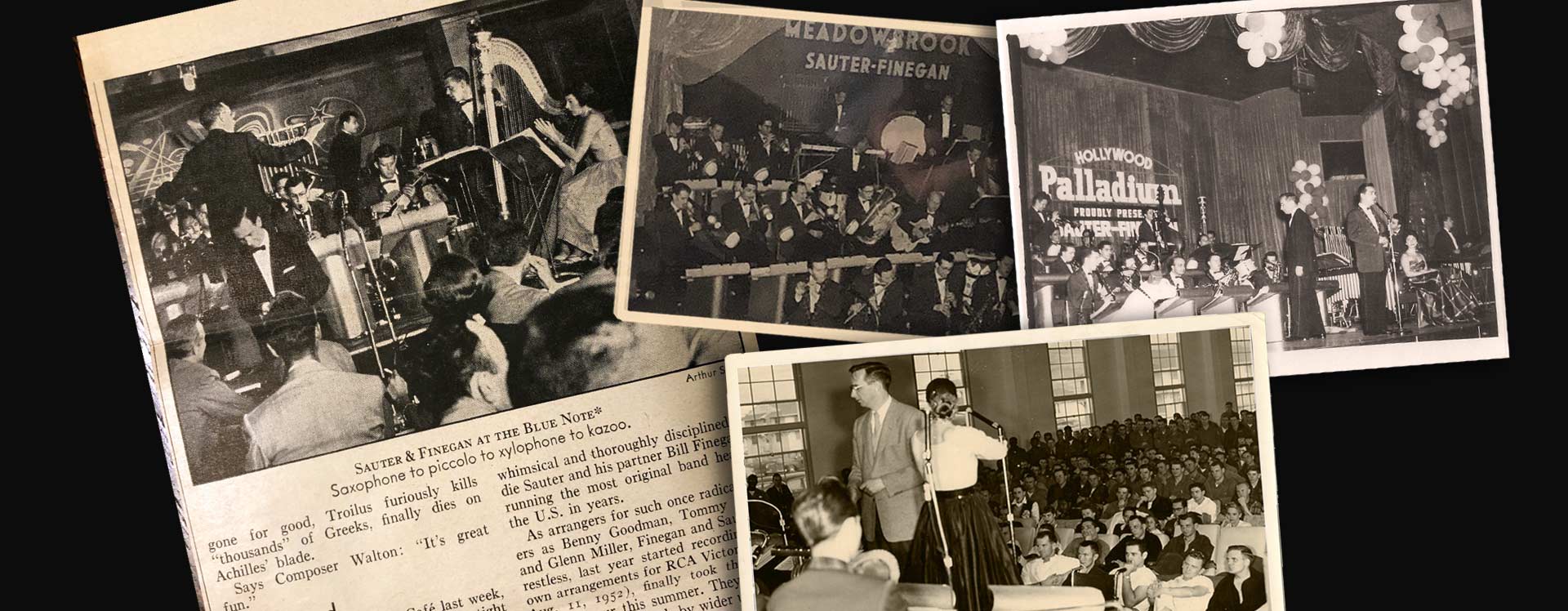

Photo above: The Sauter-Finegan Orchestra at the Blue Note, the Hollywood Palladium, the Meadowbrook. and entertaining at Nellis Air Force base, Nevada. Below: The Sauter-Finegan bus gets ready to pull out of Allentown, PA, circa 1953. (Video opens in a new window.)
The tour, according to Sauter, went nonstop from May 1953 until December 1956.
The arranger was not keen on the idea of all the time he was going to have to spend on the road. "I hated to be away from the family all that time, as much as you had to be. Both my sons were about ten and eleven; I wanted to be home."
In addition to missing his family, Sauter also had his unstable health to handle. Fortunately, Sauter's bandmates provided the support he needed to get through the arduous travels. "I put a cot on the bus and made sure I got a lot of rest, but I think what saved me there was the laughter. There were a bunch of kooks on that band and it was never boring."
With the rigors of running a touring band, there were additional tasks that the Sauter-Finegan group needed outside of writing and performing the arrangements. For one, the copyist work was crucial with so many players and such a high volume of musical output. To assist in this matter, Bill Finegan's wife, Kay Finegan, served as copyist for the ensemble.
In addition to the number of parts that needed to be addressed, the wide variety of sounds the band produced was such that a totally acoustic performance would not allow for the proper balance; a harp, for example, simply could not compete with a cavernous room and a full house.
Luckily for Sauter and Finegan, Eddie's brother Stan Meyers was an electrical engineer who had extensive knowledge of amplification technology. He set about to address the audio needs of the band as found in this 1953 touring band program:
[Stan] devised a special micing system for them, which consists of six microphones, strategically placed so that the sounds, that might ordinarily be lost amidst the band's complicated scorings, will be brought out to live audiences just the way they are on the records. In front of the band is a control panel. By means of turning knobs, Eddie or Bill (whoever happens to be conducting) can turn on any one or more of the various mics to any desired volume.
While the Sauter-Finegan Orchestra presented several originals and a number of standards, the majority of the arrangements did not feature extended solo improvisations, although solos were present everywhere as miniature commentaries. This was yet another aspect that set Sauter-Finegan apart from other swing ensembles that had preceded it.
A number of pieces by the oversized big band paid homage to the world of classical music. One such number, "Midnight Sleighride" served as a jingle-bell loaded adaptation (a Sauter-Finegan collaboration) of a section of Prokofiev's Lieutenant Kije. A television appearance of the band performing "Sleighride" revealed that Bill Finegan's percussive beating of his chest created the sound of the horse's hooves heard on the recording.
A third work by Sauter, "Wild Wings in the Woods," is a through-composed, quirky woodwind chamber ensemble piece. Featuring two flutes, oboe, clarinet, and bass clarinet, the work stretched the abilities of the jazzmen saxophone section. Wally Kane, who sat in that section, recalled the look of horror that came over baritone saxophonist Gene Allen's face when he was presented with the bass clarinet part to "Wild Wings." In fact, the woodwind section actually rented a hotel room for a day to rehearse their parts. Recorded in 1954, the composition demonstrates Sauter's versatility. Later in life, he would point with pride to that piece.
Recommended: Listen on headphones or external speakers.
Sauter-Finegan Orchestra
"Wild Wings in the Woods" – February, 1954
Eddie Sauter composition
THE FEBRUARY 1954 BAND: Joe Ferrante, Bobby Nichols, Nick Travis (trumpets); Bill Harris, Vern Friley (trombones); Bart Varsalona (bass trombone); Bill Barber (tuba); Sid Cooper, Al Klink (alto sax, clarinet, flute); Babe Fresk (tenor sax, clarinet); Boomie Richman (tenor sax, bass clarinet); Sol Schlinger (baritone sax, reeds); Ralph Burns (piano); Verley Mills (harp); Barry Galbraith (guitar); Trigger Alpert (bass); Don Lamond (drums); Walter Rosenberger, Jim Timmens (percussion); Eddie Sauter, Bill Finegan (arrangers, directors).
"The Loop" – October, 1954
Eddie Sauter composition
Solos by Nick Travis, trumpet; Gene Allen, baritone sax; Joe Venuto, xylophone
THE OCTOBER 1954 BAND: Al Maiorca, Bobby Nichols, Nick Travis (trumpets); Sonny Russo, Jimmy Thompson (trombones); Tom Mitchell (bass trombone); Jay McAllister (tuba); Harvey Estrin, Wally Kane (alto sax); Al Block, Ray Shiner (tenor sax, reeds); Gene Allen (baritone sax); Harvey Estrin, Wally Kane (clarinet); Charlie Henry (piano); Eddie Vito (harp); Mundell Lowe (guitar); Francis James (bass); Mousie Alexander (drums); Sperie Karas, Joe Venuto (percussion); Anita Darian, Andy Roberts (vocals); Eddie Sauter, Bill Finegan (arrangers, conductors).
A NOTE ON THE LOOP: While the label on the record credits both Sauter and Finegan as the authors, this is not, in fact, the case. "The Loop" is solely an Eddie Sauter composition. Proof of this can be had by checking the script on the score pages, now housed at the Yale Music Library. Further, when "The Loop" was written in 1954, Finegan and Sauter had long been working independently of each other. In fact, they collaborated on only the first twenty arrangements, which date to 1952 and early 1953. — Greg Sauter
"There were a bunch of kooks on that band and it was never boring." — Eddie Sauter